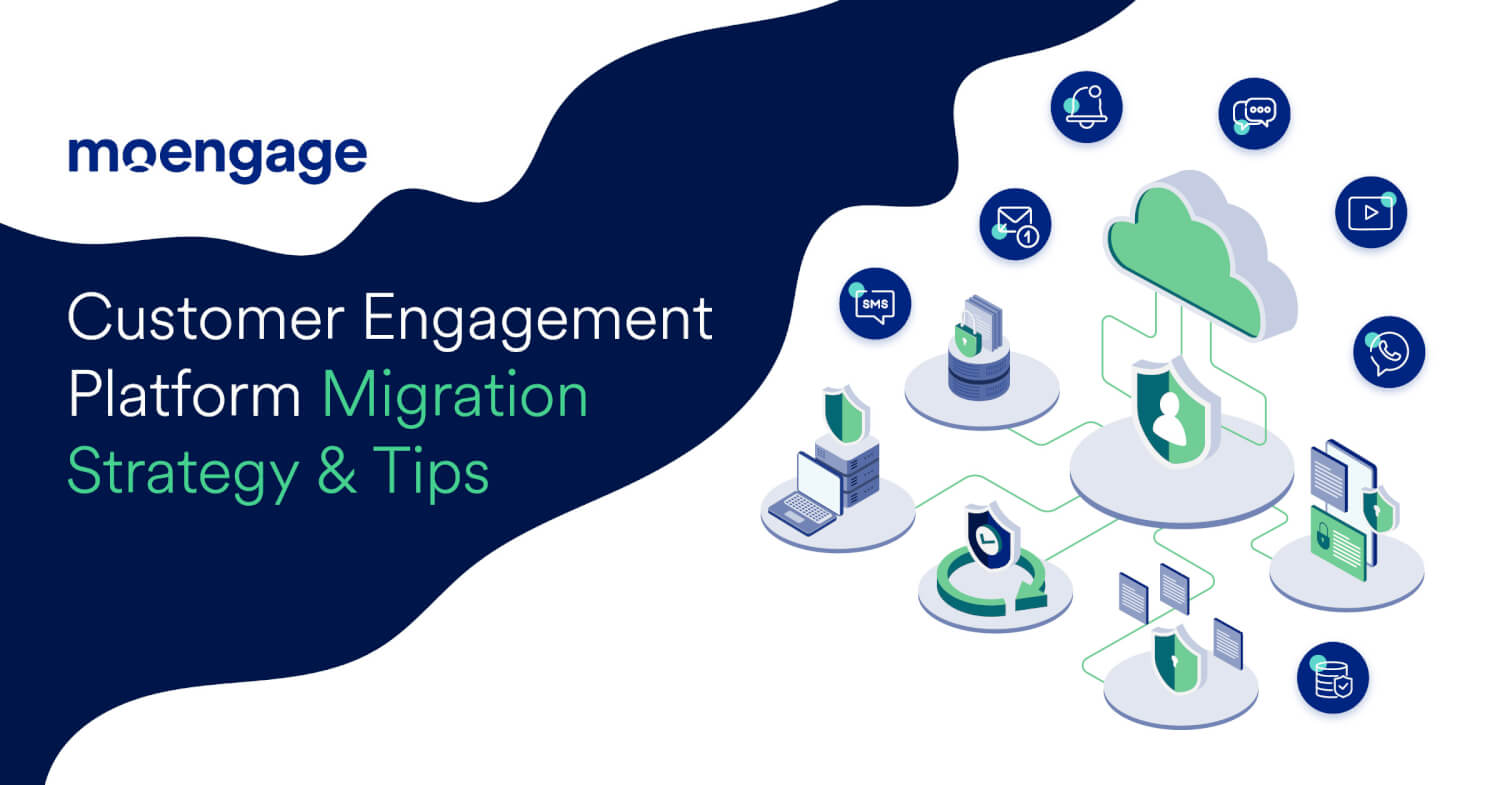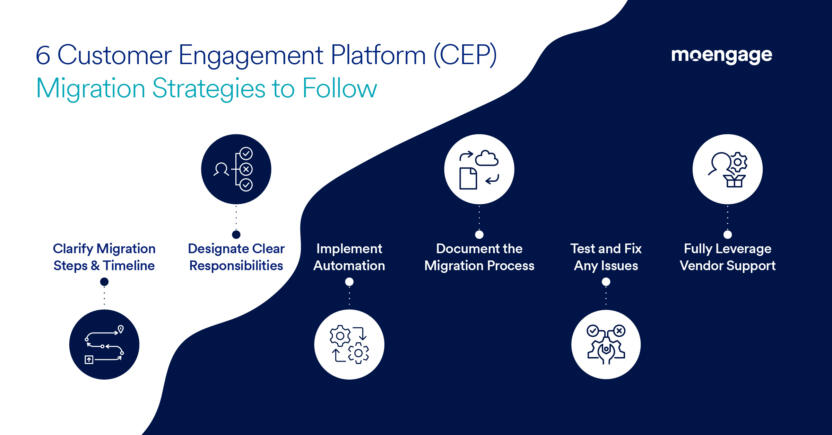Customer Engagement Platform Migration Strategy & Tips

Reading Time: 10 minutes
Many companies rely on rigid, outdated, legacy systems that don’t empower them to keep up with the fast-paced nature of modern consumers or scale to meet their growth. Others depend on a multitude of integrated point solutions that make it challenging to execute engagement effectively.
However, shifting to a new system can seem incredibly daunting; it means rewriting your processes and procedures, learning a new solution from scratch, and migrating your precious data. And with this shift come risks, including how secure the data transfer is, how long it will take to learn the new system and execute campaigns, and how long before you’ll get value from the costs associated with the migration.
It’s no surprise then, that many companies have anxiety around making this shift. Despite knowing that a change will certainly be beneficial, it means leaving the perceived safety of what you know and venturing into the unknown. However, this ‘safety’ is really only based on your familiarity with the system, and not its actual ability to deliver the customer engagement features and capabilities required to meet customer expectations.
Potential risks aside, without the right system in place, you’re missing out on critical engagement opportunities because you don’t have an optimized marketing tech stack for customer engagement.
In this article, we’ll help you get a kickstart on navigating the complex (and sometimes scary) migration process by explaining the benefits of platform migration and how to do it successfully.
What is Platform Migration & Why is it Important?
A platform migration is the process of transferring your organization’s digital assets from an existing solution to a new one. This means migrating all of your data, including customer details, account information, campaigns, content, and more.
Consumer behavior is constantly changing which means that marketers must regularly assess and evaluate the technology they use to engage them.. At the same time, technology is also evolving rapidly. Failing to adapt can lead to significant drops in efficiency and output, leading to higher customer churn and lost revenue.
Updating your tech stack is critical to ensure your operations can maintain pace as you scale and grow. Sometimes, this can be done using an upgrade to your existing solution, an add-on, or a third-party integration, but in other cases, it may be time for a full platform migration.
What Does a Customer Engagement Platform Migration Entail?
A customer engagement platform (CEP) migration involves consolidating data from your existing systems and migrating it to a new CEP. By the end of a CEP migration, you’ll have fully migrated all your data and have your new system fully set up and operational. This means transferring all customer data, campaign data, and customer journey data.
When migrating to a new customer engagement platform, you’ll need to take a number of crucial steps. The platform migration checklist below lists a few of the main things you need to do to complete the migration.
- Establish your new data taxonomy and structure: Design the data taxonomy you plan on using on your new platform and restructure your old data to fit this new system. Make sure you’re thoughtful about your structure and configure your data so you’re able to leverage new features and capabilities effectively.
- Set up your integrations: It’s often ideal to have your integrations set up as much as possible before migrating data to avoid issues. Set up your integrations for web, iOS, Android SDK, email onboarding (and for other channels), and APIs so the back-end is operational.
- Migrate user profiles and customer data: Migrate your customer data, including user attributions and properties like their personal details and account information, as well as customer activity data and preferences.
- Migrate all relevant campaign data: Salvage your existing (and winning) campaigns by migrating all campaign data, including metadata, segments, content, and scheduling. Make sure you keep your leading campaigns while fitting them into your new system so you can integrate additional features.
- Migrate customer journey data: Keep successful journeys intact by migrating all customer journey data, including customer journey maps, website and mobile app navigation insights, cohort insights, etc,
- Migrate data for additional functionality: Now’s the time to migrate any data related to optional features you’re looking to take advantage of, including any data relevant to a Dynamically Personalized Messaging (DPM) setup, a content API setup, or PII tokenization.
You must migrate all your data securely without loss. It’s a daunting task and you need to trust the provider you choose with your data. To help you make the right choice, we’ve created a CEP buyer’s guide, complete with a breakdown of an enterprise-level migration process.
How to tell your customer engagement platform isn’t working
If you aren’t seeing the engagement you expect from your campaigns, or they simply take too much time and effort to deploy and manage, it may be a sign that you need to update your CEP.
Below, we look at some top signals that your current CEP is no longer performing up to standard (and may need to be replaced).
- Lack of automation capabilities: As your business grows, it becomes impossible to do work manually, at scale. These processes can cause operational friction and inefficiencies, and can even lead to bottlenecks that completely halt operations.
- The tech stack is too slow: Whether your team is too reliant on developers, your data is siloed, or the interface of your current CEP is subpar, issues with your tech stack can result in gaps between your planning and execution and can make it extremely difficult to react quickly and correct course when things go south.
- The current system has become too complex: If you’re operating too many campaigns and initiatives across various platforms and struggling to effectively keep track, organize, and manage them all, you may need to consolidate your efforts with a single solution that can do more.
- Limited integration capabilities: A CEP needs to be able to integrate seamlessly with the other tools and software that make up your Martech stack. It must also empower your team to deliver better customer experiences while improving operational efficiency.
- Insufficient customer support: Your vendor shouldn’t just sell you a product, they should support you from onboarding, to integration, and through to ongoing use, ensuring that you’re consistently getting the most out of your CEP. Adequate support is critical to ensure that you can resolve issues proactively and minimize downtime.
- Missing intuitive features: A single person has a limit on how much they can test and implement. With AI, companies can go beyond human capabilities and do things humans can’t, like predict customer actions, test numerous campaigns at scale, and make course-corrections in real-time.
- Customer and campaign insights are unclear: A CEP needs to empower you to understand your customers’ activity and behavior so you can provide better customer experiences. If you’re struggling with data silos, don’t have real-time analytics, or your data simply isn’t comprehensive or accurate enough, you’ll struggle to find actionable insights and run effective campaigns.
For a more in-depth analysis of why you should be using a modern, mobile-first customer engagement platform that’s insights-led, review our full list of warning signs you need an intelligent customer engagement platform.
6 Customer Engagement Platform Migration Strategies to Follow
Now that you know the basic steps to follow in the initial phase of the migration and what to look for in your own system that may warrant a migration, it’s time to look at top strategies for carrying out your migration successfully to completion.

Below, we cover some of the best CEP migration strategies and best practices to follow.
1. Clarify the required steps and phases to establish a realistic timeline
Work with your new vendor to map out each stage of the migration, including migration elements, what each step entails and timelines, and who would need to be involved from both teams. Review this with your team and your CEP’s team to set it in stone.
- Be specific: Don’t just identify “data migration” as a stage, but list the data components (like user attributes and properties), and how it’s being imported (CSV or API) to make sure everything is accounted for.
- Be realistic: Ensure your team has the bandwidth to contribute to each stage as you have mapped it out, and ask for examples from your CEP of migrations they have completed that require a similar amount of work to set a realistic goal for how long the migration will take.
- Hold everyone accountable: Ensure all team members follow the established timeline and designate someone responsible for policing this throughout the migration process.
💡Fun Fact: Drop, a card-linked offers and rewards app, went live via MoEngage in just seven days. Our flexibility and ease of integration ensured they had well-documented SDKs and APIs so they could easily import historical data, integrate customer and event data, and set up server-to-server backend events so they could quickly and easily activate email and push notifications.
2. Establish a team and designate clear responsibilities for each person
You’ll likely want to appoint a designated team for the migration job, with stakeholders from all necessary teams and departments, such as product development, marketing, IT, and data management. The goal is to have a CEP that enables all of your team members to do their jobs more effectively and efficiently, so you’ll want to tap their insights and expertise when planning and implementing the migration to ensure each team’s needs will be met.
- Be inclusive: Include stakeholders from all departments so that every department has direct access and can provide input.
- Stay in touch: Don’t just meet once at the start of the process; make sure you check in regularly with each other and have open lines of communication so you can work cooperatively towards the same goal.
- Appoint a leader: You still want all teams to have an equal say, but it’s a good idea to put someone in charge of the project to help keep it on track and provide a centralized management system for the migration process.
3. Automate any components of the process that you can
Manual procedures can be a huge time suck on the migration process and often lead to significant downtime, cause bottlenecks, and result in a longer wait before your engagement campaigns are deployed. Automating as much of the process as possible will help you save time and allocate resources more effectively.
- Automate and simplify data transfer: Streamline the data migration process by leveraging tools that make it easy to automatically transfer bulk data at once. Use an API to create a direct connection and leverage CSV imports rather than copying data manually from spreadsheets and databases.
- Cooperatively manage your workflow: Create an intuitive system for managing and tracking your progress. Ensure all teams have access, can easily share their input, and track what they’ve completed so all stakeholders are in the loop. The more automated this workflow process is, the more time can be devoted to the actual migration.
4. Document the process thoroughly for use post-migration
It’s important that your team can carry out everything they need to efficiently and potentially even replicate the process in the future. Your new provider should give you thorough documentation for APIs and SDKs so you can confidently set up data transfers, and potentially refer back to this documentation.
- Make sure you have what you need: Review the documentation thoroughly at the start to make sure you have everything you need, and don’t be afraid to request updated documentation or clarification where needed so your migration can proceed smoothly.
- Keep notes for later: You never know when you’ll need to make changes to your infrastructure, and there may be a time when you need to migrate more data. Make sure you keep clear documentation and thorough notes on the process so it can be repeated in the future.
- Be precise: Make sure the documentation you have (and the notes you leave for yourselves) are precise and detailed so that people can easily interpret them and follow them. Ideally, an entirely new migration team should be able to go off the documentation alone if need be.
5. Test and fix any issues during the migration – not after
Despite your best efforts, when you flick the ‘on’ switch, it’s unlikely that absolutely everything works without a hitch. Make sure you allow time to test your system and that you have a well-defined plan for doing so. Don’t just check off easy boxes, but rigorously test that the new platform will perform as expected. It’s critical you run these tests immediately after setup while you still have the vendor’s support.
- Be calculated: Establish a clear plan to test whether the platform meets your expectations. Have clearly defined, measurable methods of testing the performance of your campaigns via the new CEP.
- Be comprehensive: Remember how we insisted that all stakeholders and departments have input? That’s crucial at this stage as well. Make sure all teams test the system and ensure it will enable them to perform their roles as expected.
- Vigorously test performance: Now’s the time to make sure everything is working as it should be. Don’t conduct easy-to-pass tests at this stage, test the solution to its limits and try out the capabilities of different features to ensure the CEP is meeting your needs.
6. Leverage onboarding and post-onboarding support from your vendor
Even with all the preparation in the world, you won’t be poised to take advantage of all the CEPs capabilities on day one. Make sure to get some onboarding support to get familiar with the tool, complete with training and additional time to acclimatize yourself. But make sure your provider doesn’t just disappear after setup, and that they’re around to provide consistent support in the coming months as your team adjusts to the new platform.
- Establish a training program: Work with your vendor to set up a clear training program with a rigid schedule. Onboard and get everyone up to speed as fast as possible while ensuring they can take advantage of the new platform’s core features and capabilities.
- Work post-onboarding support into your timeline: Before you even start, set a clear target for your team to fully utilize the new platform. Establish this timeframe with your vendor and ensure you’ll have adequate support.
- Host periodic catch-ups with your vendor: Maintain a point of contact with your CEP vendor. Meet regularly to discuss campaign performance and feature updates, and brainstorm future ideas that will help you leverage the CEP to optimize your campaigns and remove any bottlenecks.
💡When working with ClickRain, the MoEngage Professional Services team clearly defined all phases and steps of the onboarding process and provided full transparency on progress along the way. This ensured a swift, seamless migration from their legacy solution and weekly training on key touch points so they could be fully operational once the migration was complete.
Complete a Quick, Stress-Free CEP Migration with MoEngage
Whether you’re a small business or an enterprise-level organization, a CEP migration is a daunting task that naturally brings with it some fears and anxiety. While this new solution may be intimidating in the short term, most brands know that a shift to a more modern, intuitive solution is for the best. Still, though, making that leap—and a final decision—can still be difficult.
Here at MoEngage, we understand that this process can be uncomfortable, which is why we aim to make it as painless and expedient as possible. Our Customer Engagement Platform (CEP) has a future-ready tech stack that’s agile and scalable, so you can adapt to your customers’ ever-changing needs and preferences.
But it isn’t just about convenience and peace of mind, it’s also about mitigating downtime so you can stay operational. We work quickly to get you live and operational so your campaigns can get back on track. And our job doesn’t end there either; we support our customers well beyond onboarding, offering them end-to-end support so they can always get the most out of MoEngage.
Learn how seamless the implementation process was for brands that moved to MoEngage with real-life examples from our clients.
Also, schedule a demo with our sales team today to learn how we handle CEP migrations and how we can help your business achieve its engagement goals.

















